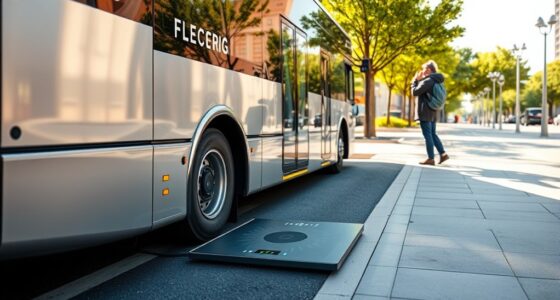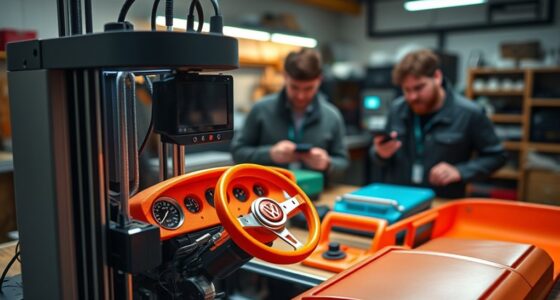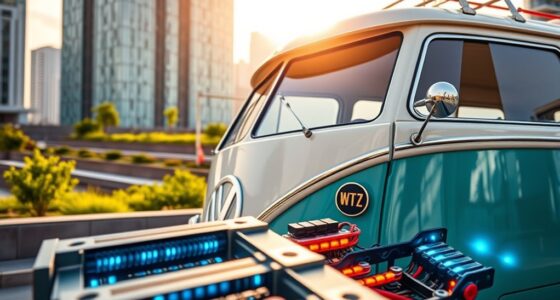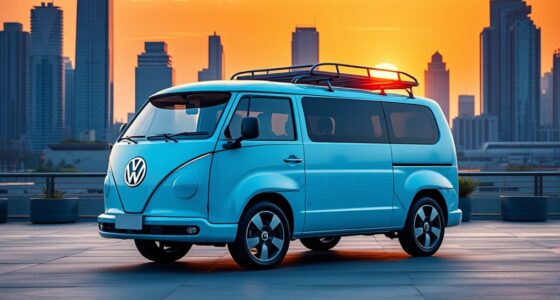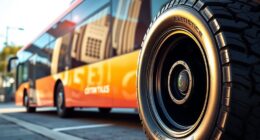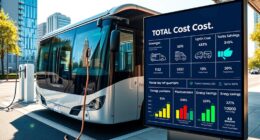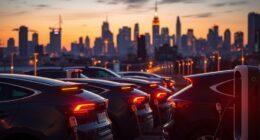The journey to the ID Buzz began with the classic Volkswagen microbus, a symbol of freedom and adventure in the 1960s. Over time, design concepts evolved, blending nostalgic shapes with modern, aerodynamic efficiency. Volkswagen integrated sustainable materials and smart technology to reimagine this icon as a sleek electric vehicle. This transformation honors its heritage while embracing innovation, showcasing how visionary ideas turned into today’s eco-friendly VW electric bus—continue exploring to see how history shaped this futuristic ride.
Key Takeaways
- Concept vehicles in the early 2010s previewed the ID Buzz’s futuristic design and electric platform.
- Volkswagen integrated sustainability and advanced technology into the ID Buzz’s development.
- The design evolved from the classic microbus silhouette to a sleek, aerodynamic electric form.
- Innovations in materials and digital interfaces emphasized eco-friendliness and modern convenience.
- The successful transition from concept to production reflects VW’s commitment to nostalgic innovation and sustainable mobility.
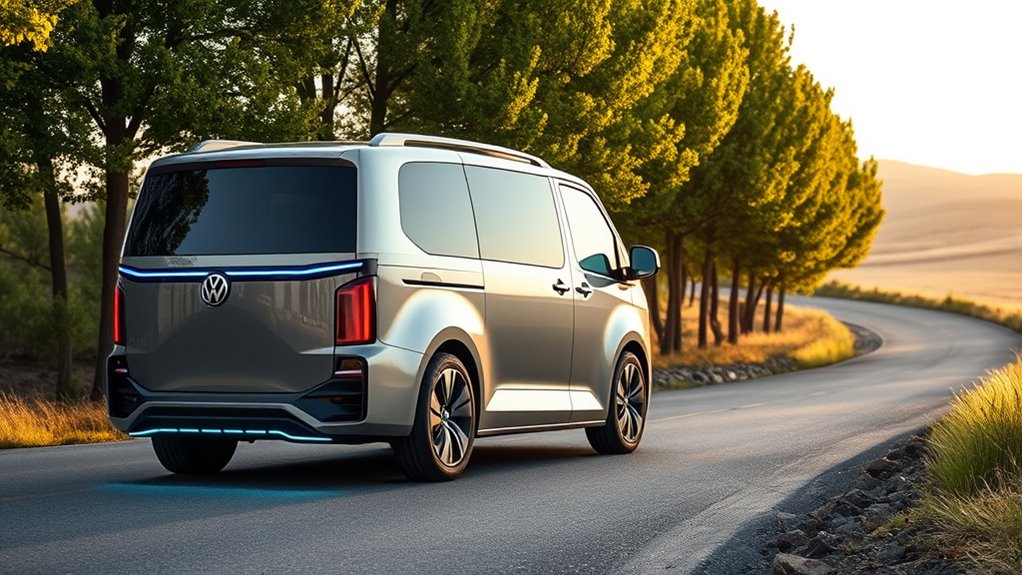
Have you ever wondered how Volkswagen’s iconic microbus is making a modern comeback? The journey from its classic roots to today’s electric marvel isn’t just about nostalgia; it’s about honoring an electric heritage while embracing a bold design evolution. The original VW microbus, or Type 2, became a symbol of freedom and innovation in the 1960s, capturing the spirit of a generation. Now, Volkswagen aims to blend that legacy with cutting-edge technology, creating an electric vehicle that respects its history but pushes forward into the future.
Volkswagen’s microbus makes a modern electric comeback blending heritage with innovative design.
The electric heritage of the ID Buzz is rooted in the microbus’s cultural significance. You can see it in the rounded, friendly shape and the spacious, versatile interior that made it a favorite among families, travelers, and adventurers. Volkswagen’s designers didn’t just replicate the past; they reinterpreted it. They took cues from the classic silhouette—its iconic wheel arches, smooth curves, and welcoming stance—and infused these elements into a modern electric framework. The result is a vehicle that feels familiar yet fresh, balancing nostalgia with innovation.
The design evolution of the ID Buzz reflects Volkswagen’s commitment to sustainability and futuristic aesthetics. Gone are the bulky internal combustion engine components; instead, the bus boasts a sleek, aerodynamic form optimized for efficiency. The front end is minimalist, with LED lighting accents that echo the vintage microbus’s round headlights but reimagined in a contemporary style. The roofline remains high, providing ample headroom and a spacious interior, while the large windows emphasize its openness and connection to the outdoors. The overall design signals a clear shift from the traditional, utilitarian microbus to a forward-looking electric vehicle that appeals to modern sensibilities.
Inside, the evolution continues with a focus on digital interfaces and sustainable materials. You’ll find a minimalist dashboard, intuitive controls, and an expansive infotainment system that integrates seamlessly with your devices. The seating arrangements are flexible, emphasizing comfort and practicality. Volkswagen has maintained the microbus’s ethos of community and adventure, now enhanced by smart technology and eco-conscious choices. Additionally, the use of sustainable materials in the interior design highlights Volkswagen’s dedication to environmentally friendly manufacturing practices.
The journey to the ID Buzz exemplifies how a brand can honor its electric heritage while evolving its design language to meet contemporary needs. Volkswagen’s microbus isn’t just a nostalgic nod; it’s a statement of innovation and respect for the past, combined with a clear vision for the future. As it hits the roads, it reminds us that progress can honor tradition, and the road ahead is electric.
Frequently Asked Questions
What Inspired Volkswagen’s Shift to Electric Vehicle Design?
You see, Volkswagen’s shift to electric vehicle design is driven by sustainable innovation and changing consumer expectations. You’re inspired by the need to reduce environmental impact while meeting demand for eco-friendly transportation. This progression reflects your commitment to cutting emissions and embracing new technology, showing that you’re not just following trends but actively shaping a sustainable future. Your focus is on creating vehicles that align with both environmental goals and customer desires.
How Did Concept Cars Influence the ID Buzz Development?
You’ll find that concept car innovations really paved the way for the ID Buzz’s design influence. These futuristic concepts showcased cutting-edge features, bold aesthetics, and new technologies, acting as a blueprint for VW’s electric bus. They allowed designers to experiment and push boundaries, giving you a glimpse of what’s possible. In principle, concept cars served as a spark that ignited the creative process, transforming visionary ideas into a tangible, eco-friendly vehicle.
What Challenges Did VW Face During the Electric Bus’s Design Process?
During the electric bus’s design process, you face battery challenges that limit range and charging times, making it hard to meet customer expectations. Design constraints also restrict creativity, as engineers must balance aerodynamics, space, and safety features within tight parameters. These hurdles require innovative solutions to optimize performance without compromising comfort or style, pushing your team to constantly adapt and refine the vehicle’s development to overcome these obstacles effectively.
Are There Future Plans for Expanding the ID Series Lineup?
Imagine a future where your drive feels seamless, powered by a growing ID series. VW plans to expand this lineup, focusing on battery innovation to boost range and performance. They’re also investing in charging infrastructure, making quick, widespread charging stations a reality. With these advancements, the ID series will offer more versatile electric options, so you can enjoy reliable, eco-friendly travel wherever your journey takes you.
How Does the ID Buzz Compare to Traditional VW Buses in Performance?
You’ll find that the ID Buzz offers a modern take on vintage nostalgia, blending classic VW bus design with advanced electric performance. Unlike traditional VW buses, it delivers quicker acceleration, smoother handling, and zero emissions. Its design evolution emphasizes aerodynamic efficiency and tech integration, making it more eco-friendly and practical. Overall, the ID Buzz elevates the iconic bus experience with contemporary performance, transforming nostalgia into a forward-thinking, sustainable ride.
Conclusion
You’ve seen how VW’s vision for the ID Buzz evolved from a futuristic concept to a real electric bus. Imagine this: by 2030, VW aims to sell over 1.5 million electric vehicles annually. That’s like filling a stadium the size of Wembley every month with eco-friendly rides. It’s incredible to think how bold ideas can turn into everyday realities, shaping the future of transportation and making a cleaner planet within reach.


